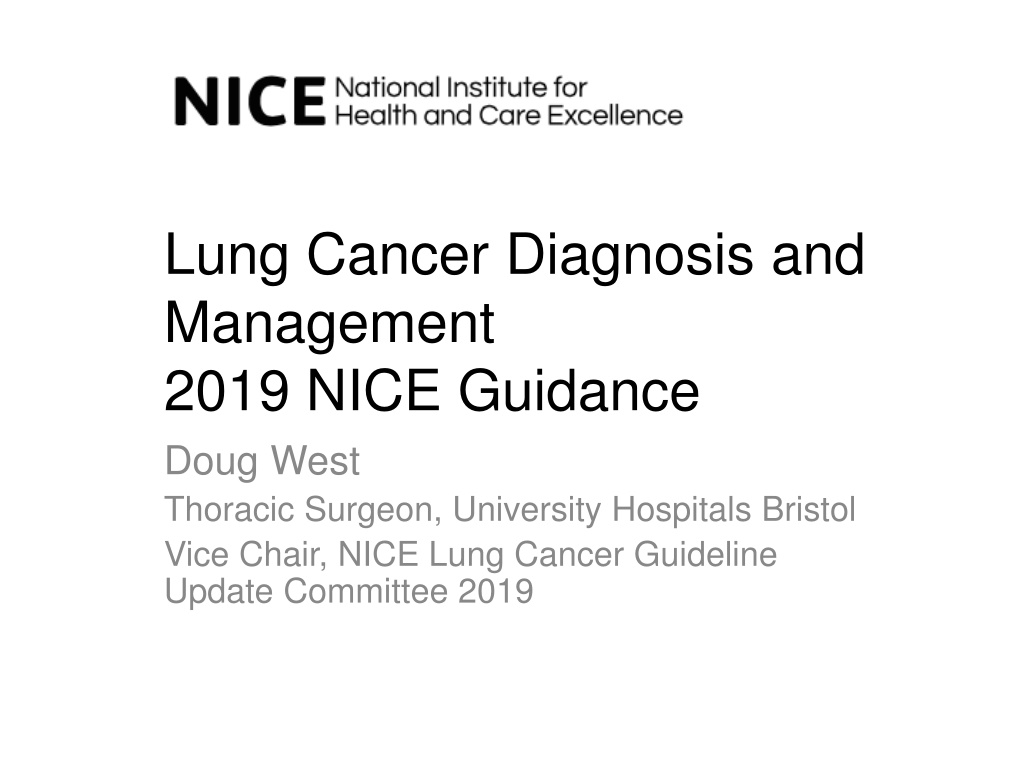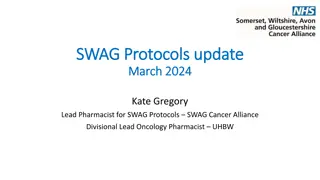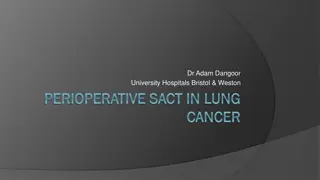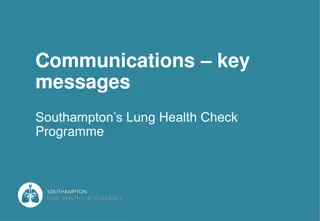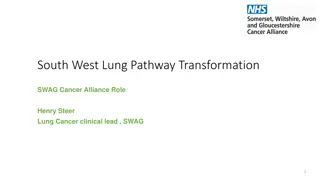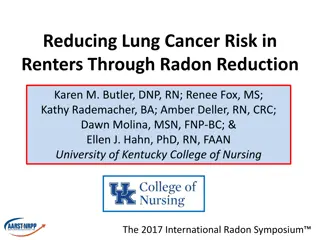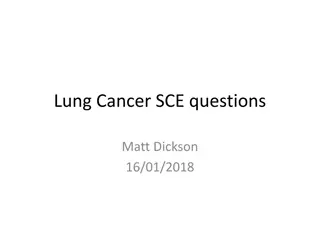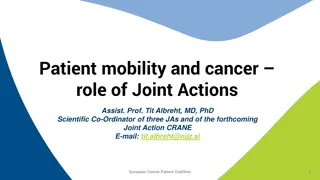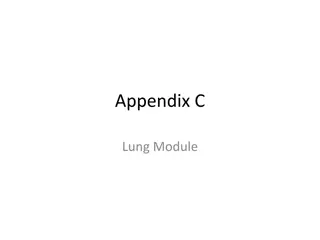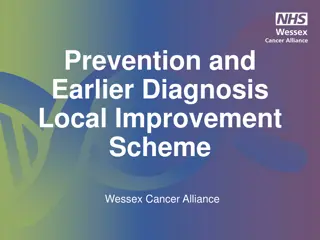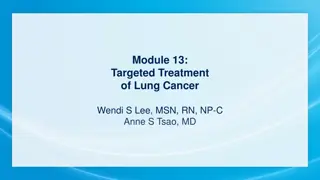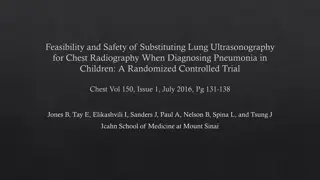Comprehensive Update on Lung Cancer Diagnosis and Management According to 2019 NICE Guidelines
Providing a detailed overview of the 2019 NICE guidance on lung cancer, this content covers various aspects including the role of NICE, types of guidance provided, updates on lung cancer surgery, recommendations on tobacco addiction interventions, diagnostic approaches, and new protocols for brain imaging in lung cancer staging. The information is sourced from experts in the field and aims to enhance understanding and application of the latest recommendations for optimal patient care.
Uploaded on Sep 25, 2024 | 0 Views
Download Presentation

Please find below an Image/Link to download the presentation.
The content on the website is provided AS IS for your information and personal use only. It may not be sold, licensed, or shared on other websites without obtaining consent from the author. Download presentation by click this link. If you encounter any issues during the download, it is possible that the publisher has removed the file from their server.
E N D
Presentation Transcript
Lung Cancer Diagnosis and Management 2019 NICE Guidance Doug West Thoracic Surgeon, University Hospitals Bristol Vice Chair, NICE Lung Cancer Guideline Update Committee 2019
Who are NICE? Founded 1999 Public body within Department of Health Guidance covers England and Wales Improving health and social care through evidence- based guidance Considers safety, clinical and cost effectiveness (as QALYs/ICERs*). QALY threshold c 20,000- 30,000/QALY *Incremental cost effectiveness ratio
Types of NICE guidance Clinical Guidelines Technology Appraisals (TAs) Interventional Procedures Guidance Quality standards Language: consider vs. offer
BTS/SCTS guidance now superceded
Lung cancer surgery Significant and continuing rise in activity Improved peri- operative care and falling mortality likely to increase further TBC; screening and stage migration 8,000 7,000 6,000 5,000 4,000 3,000 2,000 1,000 0
Tobacco addiction Stop smoking interventions and services 1.4.1 Inform people that smoking increases the risk of pulmonary complications after lung cancer surgery. [2011] 1.4.2 Advise people to stop smoking as soon as the diagnosis of lung cancer is suspected and tell them why this is important. [2011] 1.4.3 Offer nicotine replacement therapy and other therapies to help people to stop smoking in line with the NICE guideline on stop smoking interventions and services and the NICE technology appraisal guidance on varenicline for smoking cessation. [2011] 1.4.4 Do not postpone surgery for lung cancer to allow people to stop smoking. [2011]
Diagnosis CT chest and upper abdo for all FDG CT-PET if radical therapy contemplated May be role for MRI in superior sulcus (Pancoast) tumours
New 2019: Brain imaging Workup for radical therapy Stage I No imaging after PET-CT Stage II Brain CT Stage III Brain MRI
Brain imaging- why? Already included in co-registration CT for PET Undiagnosed (clinically and radiologically) brain metastases Risk of futile radical therapy / unnecessary reduction in HRQoL Risk of occult mets. increases with stage
Brain imaging- why? Already included in co-registration CT for PET Undiagnosed (clinically and radiologically) brain metastases Risk of futile radical therapy / unnecessary reduction in HRQoL Risk of occult mets. increases with stage Evidence review 1.5-21.4% of stage I-IIIA will have mets on MRI Expectation: more brain imaging and therapy (SABR etc) for brain mets
Staging Offer PET-CT (if not already done), followed by EBUS-TBNA and/or EUS-FNA, to people with suspected lung cancer who have enlarged intrathoracic lymph nodes (lymph nodes greater than or equal to 10 mm short axis on CT) and who could potentially have treatment with curative intent. [2019] 1.3.20 Evaluate PET-CT-positive or enlarged intrathoracic nodes using a systematic approach[3] with EBUS-TBNA and/or EUS-FNA if nodal status would affect the treatment plan. [2019] 1.3.21 Consider surgical mediastinal staging for people with a negative EBUS-TBNA or EUS-FNA if clinical suspicion of nodal malignancy is high and nodal status would affect their treatment plan. [2019] Reducing role for bronchoscopy
Invasive node staging: move to EBUS PET-CT PET-CT+EBUS PET-CT+ EBUS Declining role for mediastinoscopy; role in PET-avid mediastinum with negative EBUS but poor quality/uncertain
Declining role of mediastinoscopy EBUS-TBNA / EUS first line for invasive mediastinal staging Role in confirming EBUS results IF clinical staging of nodal malignancy is high AND nodal status would affect their treatment plan
Fitness assessment before surgery Perform spirometry and transfer factor (TLCO) in all people being considered for treatment with curative intent. [2011, amended 2019] Offer people surgery if they have a forced expiratory volume in 1 second (FEV1) within normal limits and good exercise tolerance. [2011] When considering surgery perform a functional segment count to predict postoperative lung function. [2011] Offer people with predicted postoperative FEV1 or TLCO below 30% the option of treatment with curative intent if they accept the risks of dyspnoea and associated complications. Consider cardiopulmonary exercise testing to measure oxygen uptake (VO2 max) and assess lung function in people with moderate to high risk of postoperative dyspnoea, using more than 15 ml/kg/minute as a cut-off for good function. [2011]
Which operation? Lobectomy VATS or open More extensive resection only if needed for R0 margins Hilar and mediastinal sampling or resection
Unfit for lobectomy? Either or Sublobar excision (segment / wedge) Radiotherapy (SABR) *SABR- stereotactic ablative radiotherapy
Non surgical outcomes for radical treatment of early stage disease 1.4.27 For people with stage I IIA (T1a T2b, N0, M0) NSCLC who decline surgery or in whom any surgery is contraindicated, offer SABR. If SABR is contraindicated, offer either conventional or hyperfractionated radiotherapy. [2019] 1.4.28 For eligible people with stage IIIA NSCLC who cannot tolerate or who decline chemoradiotherapy (with or without surgery), consider radical radiotherapy (either conventional or hyperfractionated). [2019] 1.4.29 For eligible people with stage IIIB NSCLC who cannot tolerate or who decline chemoradiotherapy, consider radical radiotherapy (either conventional or hyperfractionated). [2019]
Multimodality therapy Consider adjuvant chemotherapy in PS 0-1 pN1-2 Consider adjuvant chemo in PS 0-1, tumour diameter >4cm Combination Cisplatin-based chemo New guidance: operable IIIA N2 For people with operable stage IIIA N2 NSCLC who can have surgery and are well enough for multimodality therapy, consider chemoradiotherapy with surgery. [2019]
Operable IIIA N2 continued 1.4.41 Discuss the benefits and risks with the person before starting chemoradiotherapy with surgery, including that: chemoradiotherapy with surgery improves progression-free survival chemoradiotherapy with surgery may improve overall survival. [2019] 1.4.42 For people with stage IIIA N2 NSCLC who are having chemoradiotherapy and surgery, ensure that their surgery is scheduled for 3 to 5 weeks after the chemoradiotherapy. [2019] 1.4.43 Multidisciplinary teams that provide chemoradiotherapy with surgery should have expertise in the combined therapy and in all of the individual components. [2019]
Small cell lung cancer surgery Consider surgery in T1-T2a N0 M0 SCLC Offer Cisplatin based chemotherapy in M0 Offer twice daily radiotherapy in M0 PS 0- 1 Mainstay of treatment is early chemotherapy and radiotherapy
SACT for Advanced Disease (M1) Radically different in age of targeted and immunotherapy Focus now on obtaining tissue sufficient for early genetics
Follow up after radical treatment 1.6.1 Offer all people with lung cancer an initial specialist follow-up appointment within 6 weeks of completing treatment to discuss ongoing care. Offer regular appointments after this, rather than relying on the person requesting appointments when they experience symptoms. [2011] 1.6.2 Offer protocol-driven follow-up led by a lung cancer clinical nurse specialist as an option for people with a life expectancy of more than 3 months. [2011] 1.6.3 Ensure that people know how to contact the lung cancer clinical nurse specialist involved in their care between their scheduled hospital visits. [2011]
This guidance does not contain any Screening (pre NELSON) VATS vs. open lung resection (waiting for VIOLET) Palliation of pleural effusion (outside scope) Mesothelioma Follow up not reviewed PACIFIC trial (IO in irresectable III N2)
This guidance does not contain any Screening (pre NELSON) VATS vs. open lung resection (waiting for VIOLET) Palliation of pleural effusion (outside scope) Mesothelioma Follow up not reviewed PACIFIC trial (IO in irresectable III N2)
This guidance does not contain any Screening (pre NELSON) VATS vs. open lung resection (waiting for VIOLET) Palliation of pleural effusion (outside scope) Mesothelioma Follow up not reviewed PACIFIC trial (IO in irresectable III N2)
Palliation of pleural effusion Out of scope for 2019 guideline update Other palliative treatments 1.5.7 Perform pleural aspiration or drainage in an attempt to relieve the symptoms of a pleural effusion. [2005] 1.5.8 Patients who benefit symptomatically from aspiration or drainage of fluid should be offered talc pleurodesis for longer-term benefit. [2005] 1.5.9 Consider non-drug interventions based on psychosocial support, breathing control and coping strategies for people with breathlessness. [2005]
Indwelling pleural catheters for malignant effusion; 2019 exceptional review Why? Concerns from NHSE Clinical Expert Group and NICE guideline committee 10 new RCTs/systematic reviews no significant differences in outcomes including success rate and improvement of dyspnoea One identified pleurodesis failure rate was higher in IPC compared with talc slurry pleurodesis . mixed evidence concerning adverse event rate with IPC several studies noted that IPC may be associated with a shorter length of hospital stay and fewer repeat pleural interventions.
Recommendations for research: the known unknowns (1) Role of immunotherapy after multimodality therapy including surgery Why?
Recommendations for research: the known unknowns PACIFIC Bx proven unresectable stage 3 NSCLC WHO 0-1 PD-L1 na ve No progression after 2 cycles chemorads Median PFS 16.8 vs. 5.6 months PD-L1 status did not influence response
Recommendations for research: the known unknowns (1) Role of immunotherapy after multimodality therapy including surgery Why? Significant PFS superiority for Durvalumab + chemoRT vs chemoRT alone in PACIFIC Similar PFS (?OS) benefits may be possible in resectable stage IIIA pN2
Recommendations for research: the known unknowns (2) SABR vs. surgery for early NSCLC
